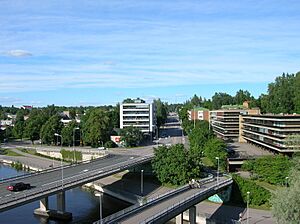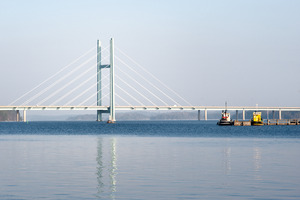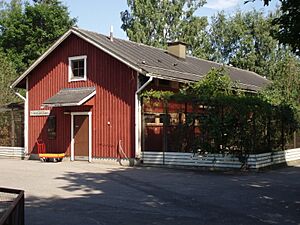Heinola facts for kids
Quick facts for kids
Heinola
|
|||
|---|---|---|---|
|
Town
|
|||
| Heinolan kaupunki Heinola stad |
|||

A view from Heinola railway bridge towards the town center
|
|||
|
|||

Location of Heinola in Finland
|
|||
| Country | |||
| Region | Päijänne Tavastia | ||
| Sub-region | Lahti sub-region (current) Heinola sub-region (former) |
||
| Charter | 1776 | ||
| City rights | 1839 | ||
| Area
(2018-01-01)
|
|||
| • Total | 839.28 km2 (324.05 sq mi) | ||
| • Land | 675.97 km2 (260.99 sq mi) | ||
| • Water | 162.96 km2 (62.92 sq mi) | ||
| Area rank | 125th largest in Finland | ||
| Population
(2023-12-31)
|
|||
| • Total | 17,953 | ||
| • Rank | 65th largest in Finland | ||
| • Density | 26.56/km2 (68.8/sq mi) | ||
| Population by native language | |||
| • Finnish | 94.7% (official) | ||
| • Swedish | 0.2% | ||
| • Others | 5% | ||
| Population by age | |||
| • 0 to 14 | 11% | ||
| • 15 to 64 | 53.9% | ||
| • 65 or older | 35.1% | ||
| Time zone | UTC+02:00 (EET) | ||
| • Summer (DST) | UTC+03:00 (EEST) | ||
| Climate | Dfc | ||
Heinola is a town and municipality in Finland. It's located in the eastern part of the Päijänne Tavastia region. Heinola is close to the borders of the South Savo and Kymenlaakso regions. It's the third largest municipality in its region by population, after Lahti and Hollola. Heinola has about 17,953 people living there.
The coat of arms of Heinola features a Eurasian lynx, which is the animal of the Tavastia region. The lynx crosses a stripe that looks like an arch bridge. This bridge represents the Jyränkö Bridge, built in 1932, which crosses the Jyrängönvirta waterway. The coat of arms was designed by Gustaf von Numers and approved in 1958. In June 2024, Heinola was even listed by The Times newspaper as a great summer vacation spot because it's not too hot!
Contents
Exploring Heinola's Past
Heinola was once a small village that belonged to a larger area called Hollola. In 1776, King Gustav III of Sweden made Heinola an important government center. This is why the city center has a planned layout, like a grid. Heinola also became a busy place for trade in the nearby areas.
When Finland became part of Russia in 1809, the main government center moved east. To make up for this, Czar Nicholas I gave Heinola its official town rights on December 26, 1839. Before World War II, Heinola was famous as a spa town, a place where people went to relax and get healthy. Until 1972, it also had a special school that trained elementary school teachers. Both the spa and the school were started in the 1890s and were very important to the town's daily life.
In 1997, the rural municipality of Heinolan maalaiskunta joined with Heinola.
Heinola's Natural Surroundings
Heinola is mostly located between two lakes: Ruotsalainen and Konnivesi. A waterway connects these lakes and flows right through the town. This waterway, along with a long, narrow hill called an esker, are key natural features of Heinola.
A major motorway (Finnish national road 4/E75) connects Heinola to Lahti (about 35 kilometers away) and Helsinki (about 138 kilometers away). This motorway crosses Lake Ruotsalainen over the Tähtiniemi Bridge in the northern part of town. Heinola is also the starting point of Finnish national road 5, which stretches over 900 kilometers north through cities like Kuopio and Kajaani all the way to Sodankylä.
Heinola's Weather
Heinola has a subarctic climate, which means it has long, cold winters and short, mild summers. It's similar to a humid continental climate.
Heinola's Economy and Jobs
After World War II, Heinola became known as an industrial town. This was mainly because of its wood processing factories. For a long time, industry provided the most jobs. However, by the 1970s, more people started working in shops and services, which was a trend happening across the country.
Did you know that Volkswagen Beetle cars were once built in Heinola?
Heinola was affected by the Late-2000s recession. UPM-Kymmene, a large company that used to be the biggest employer after the government, closed its sawmill and plywood mill in Heinola in 2010.
Fun Places to Visit in Heinola
The Heinola Bird Sanctuary is a special place located right next to the old bus station. Its main goal is to help birds that have been hurt by traffic, power lines, or windows. They try to help these birds get better so they can go back into nature. Birds that can't return to the wild, but can still live a good life in captivity, stay at the sanctuary for visitors to see. It's a great chance for school groups and tourists to learn about different bird species that are hard to spot in the wild. In the summer, you can even see tropical birds that spend the winter indoors.
Heinola's Local Culture
Traditional Foods
In the 1980s, two traditional dishes from Heinola were tappaiskeitto (which means "butchery soup") and delicious pancakes.
Heinola's Global Connections
Heinola has special connections with other towns around the world. These are called twin towns or sister cities.
 Karlshamn, Sweden
Karlshamn, Sweden Peine (district), Germany
Peine (district), Germany Piešťany, Slovakia
Piešťany, Slovakia
See also
 In Spanish: Heinola para niños
In Spanish: Heinola para niños





